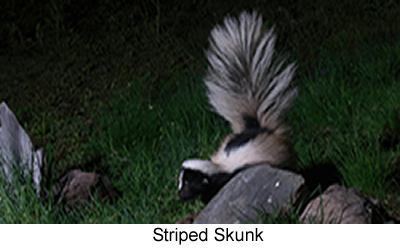 |
Name:
Striped Skunk Classification:
Class: Mammalia
Order: Carnivora
Family: Mephitidae
Genus: Mephitis
Species: M. mephitis
Size: Head-to-body 8-19 inches, tail 5-15 inches Characteristics:
Small head with snout and rounded ears, long body with very long tail,
covered in long fur, four-legged with claws. Status: Least Concern They're cute, they're fluffy, but if you get too close you'll be in for a noxious surprise! For a long time it was thought that skunks were members of the mustelid family, which includes weasels, otters and badgers. Recent research however has classed skunks and their close cousins, stink badgers, in their own separate family of mephitidae. The striped skunk is one of the most common species of skunk, found in grasslands and woodlands across North America, from northern Mexico to the middle of Canada. Striped skunks are mostly nocturnal, preferring to forage for food at night and sleep during the day. Skunks are remarkably adaptable. They are omnivores and will eat just about anything they can find, including eggs, fish, plants, fruits, insects, larvae, worms, small mammals and lizards. They are not picky about where they live; taking residence in their own burrows or burrows dug by other animals, hollowed trees or even abandoned buildings! Males always live by themselves, while females will occasionally share a den. Striped skunks mate from about mid-February to mid-March. Around two months later a mother skunk will give birth to five or six babies. Like dogs, baby skunks are born deaf and blind. They nurse from their mother for about a month and a half before venturing out of the nest. After a year they will go out on their own. Skunks are most famous for their smelly defense mechanism. When threatened, a skunk will raise its tail and shoot out a musky spray from special glands. A common misconception is that the skunk passes gas or emits an odor to make its smell; this is false. This myth has been spread unintentionally through cartoons like the Loony Toons character Pepè Le Pew. It is fine to enjoy cartoons that are meant to be fun, but keep in mind that they are not always accurate representations of animals. The liquid chemical that skunks create contains special kinds of sulfur compounds called thiols. It's not dangerous, but it can burn if it gets in your eyes, it smells terrible and it's very difficult to wash out. The skunk's spray is so powerful that most predators will avoid them unless they are starving. A skunk can spray a target up to twelve feet away! A common myth is that tomato sauce or juice will neutralize the smell of skunk spray. This is untrue; scientists have determined that tomato sauce will only mask the skunk smell without actually removing it. If you or your dog is sprayed by a skunk, a shower and a mixture of baking soda, hydrogen peroxide and detergent should do the trick. Clothes can be washed with a small amount of ammonia if they have been sprayed. Striped skunks live across North America in strong numbers. They are highly adaptive to environments and have little trouble coping when humans develop an area. Thus, their status is currently classed as least concern. In the past they were hunted for their fur as well as their meat. Their gal bladders have also been used for traditional Chinese medicines. As will other animals like rhinos and tigers, there is zero evidence that skunk body parts will improve your health! Skunks are also sometimes kept as pets, though there are many states and countries where it is illegal to do so. Wild skunks are unfortunately one of the most common carriers of the disease rabies, second only to raccoons. This is another reason why it is best to give wild animals their distance, for their safety and for yours! To learn more about these smelly critters, check out these links! BioExpidition, Striped
Skunk Page-A great place to learn more about striped skunks and other
animals!
photo credit: pexels-jackbulmer |
|
|
|
|
||
|
Contact
Us
|
||||
|
Taproot
Guru © ALL RIGHTS RESERVED
|
||||